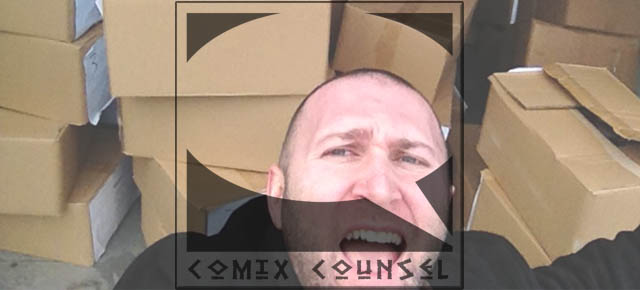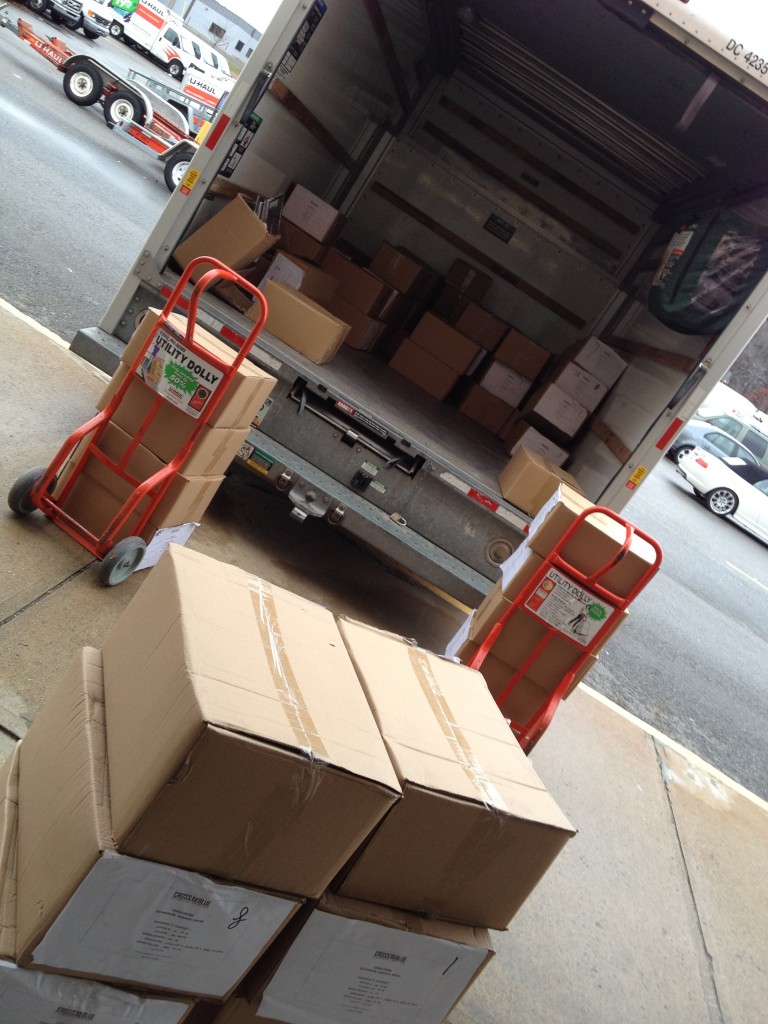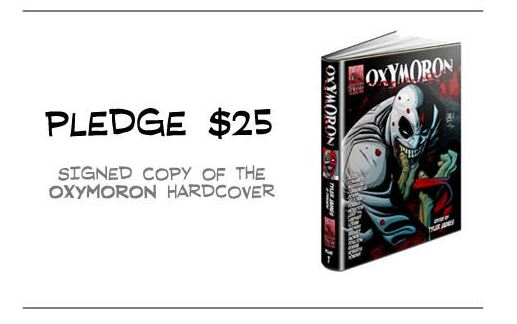DIY Crowdfunding Fulfillment Part I – What To Do BEFORE You Launch?
 I’ve written a number of columns on the comics and crowdfunding phenomenon in this space. So far, I’ve looked at Kickstarter as a pre-order vehicle compared to the Diamond pre-order system (advantage Kickstarter.) I wrote about what I thought I knew about the Kickstarter prior to running a campaign, and then followed it up with five lessons learned from running a successful campaign, and added some suggestions for how Kickstarter could be an even better platform for creators. And when I launched a crowdfunding project of my own (Oxymoron Volume 1 hardcover), I shared my approach to running that campaign. So, yes, I’ve written quite a lot on the subject…but I’ve yet to tackle what is arguably the most important part of any Kickstarter campaign. That’s right, I’m talking about fulfillment.
I’ve written a number of columns on the comics and crowdfunding phenomenon in this space. So far, I’ve looked at Kickstarter as a pre-order vehicle compared to the Diamond pre-order system (advantage Kickstarter.) I wrote about what I thought I knew about the Kickstarter prior to running a campaign, and then followed it up with five lessons learned from running a successful campaign, and added some suggestions for how Kickstarter could be an even better platform for creators. And when I launched a crowdfunding project of my own (Oxymoron Volume 1 hardcover), I shared my approach to running that campaign. So, yes, I’ve written quite a lot on the subject…but I’ve yet to tackle what is arguably the most important part of any Kickstarter campaign. That’s right, I’m talking about fulfillment.
Why has it taken me so long to write about Kickstarter fulfillment? Honestly, I think it’s because after the 80-100 total hours of work it took to fulfill my own Kickstarter project, the LAST thing I wanted to do was spend more time thinking, writing and talking about fulfillment! But, it’s been more than a year now since the OXYMORON campaign wrapped up, and several months since shipping books to my last backers, so I think I’ve sufficiently recovered to the point that I can start talking about fulfilment again. So, let’s get into what will be a multi-part series on fulfillment. To start, I want to discuss…
Fulfillment Planning BEFORE You Launch Your Crowdfunding Campaign
I recently backed a very successful and ambitious project (from a very high profile creator) and was definitely shocked when, in the first update after his campaign ended, he said he was now going to START looking for a printer. What?! Do not try this at home, kids. Even though this creator has sold literally MILLIONS more comics than I have, that post made him look like a crowdfunding amateur.
Before you launch your campaign, you should have already sourced the “Five P’s“: Printers, products, packaging, postage, and placement. To avoid a ton of headaches and stress, DO NOT launch your crowdfunding campaign until you have:
- Sourced multiple printers for your book, and received quotes on a variety of quantities (ex. 500/1000/1500), and made sure to factor in delivery dates and any extra shipping costs.
Crowdfunding Pro-Tip: Use worst case estimates in your calculations. Your printing quotes might vary significantly. While you’ll likely go with the cheapest printer, use the highest cost printer in your planning calculations, as it will give you some added cushion. When I did my campaign, one of my stretch goal bonus incentives was a comic I planned to print POD. Unfortunately, the POD printer I planned to use went out of business, and I had to go with a more expensive alternative, which increased the cost of that reward by about $250. Depending on the size of your campaign, a miscalculation like that could be REALLY painful.
- Sourced all other products used as an incentives (t-shirts, buttons, prints, stickers, etc.) and again, I’d source at least two options for each product.
Crowdfunding Pro-Tip: Don’t get crazy with the T-shirts. Yes, a well-designed tee can be a very attractive reward for project backers, and yes, offering three different choices of Oxymoron t-shirts probably helped me attract a lot more backers than if I had just one. But having done it, let me tell you…tees are a pain in the ass! For my project, I had three shirt styles, times five sizes (M, L, XL, XXL, XXXL)…that’s 15 distinct products to manage inventory for. You may be better served sticking to one or two designs, and might want to avoid the inventory management aspect entirely by having a company like Teelaunch handle your t-shirt fulfillment entirely.
UPDATE: Mention “COMIXTRIBE” and get 10% off any order at Teelaunch.com!
- Sourced all packaging materials needed to fulfill your project. You gotta love those digital rewards, man. I’ve said it before, but I think Kickstarter is actually the most profitable channel for digital sales for independent creators…far more so than Comixology. That said, most successful Kickstarters use physical rewards to raise the bulk of their funds. While you COULD slap a postage stamp on your book and drop it in the mailbox, that’ll likely be the last sale you ever make to that backer. Your physical rewards are going to need to be packaged, and you will be judged on your packaging decisions. While good packaging for your product isn’t terribly expensive, those expenses do add up and need to be accounted for prior to your campaign. Guess how much money I spend on PACKING TAPE to fulfill the 400 physical rewards for the Oxymoron book? If you guess $75, you’re in the ballpark. Tape wasn’t an expense I budgeted for…but it could have been if I had followed this:
Crowdfunding Pro-Tip: Mock-up packaging for ALL reward levels BEFORE you launch your Kickstarter. But how can I mock-up my rewards if I haven’t created my book yet? Easy, just find a similarly sized comic or graphic novel, t-shirt, print, etc. and do a dry run where you figure out, in advance, how you’re going to package that item. Then do that for ALL of your rewards.
For example, my most popular pledge level was the $25 signed copy of the Oxymoron Volume 1 Hardcover. To ship this, I would need:
(1) White Easy-Fold Mailer – 12.125 x 9.125 in (Uline model #S-342) – $0.62 each (Purchased in bundles of 100)
(1) Poly-bag -12 x 18, 1 MM (Uline model #S-3204) – $0.04 each (Purchased in bundles of 1,000)
Staples Shipping Tape – ~40 inches – $0.13 per book (Purchased in packages with a rolls of 6.)
(1) Thermal Shipping Label – $0.05 per label (Purchased in rolls of 240)
TOTAL PACKAGING COST – $1.29 per pledge at this level
Yes, if you have a ton of pledge levels, doing this estimating is going to take some time, but when it comes to Kickstarter fulfillment trust me, ignorance is NOT bliss.
Crowdfunding Pro-Tip: Buy Packaging in Bulk With U-line. When it comes to purchasing packaging supplies, you’re going to want to buy in bulk. And nobody does bulk packaging supplies better than Uline.com. A single cardboard mailer from your local Staples might cost 3-4 times what one would cost from Uline when bought in sufficient quantities. A crowdfunding project is a good time to stock up on your packaging supplies for the entire year. Also, I recommend always searching the internet for Uline coupons. Very often, they post a “Free Shipping on Orders over $300” coupon that can save BIG money. They do expire rather quickly, which is why I’m not linking to one in this article…but I’ve definitely saved hundreds by spending 10-15 minutes searching for Uline coupons online.
- Sourced postage and calculated estimated shipping costs for ALL reward levels. The US Postal Service is going to be your most cost-effective way to ship your pledges. What you’re going to want to do with the mocked-up reward packages is either take them to your local post office to get actual shipping costs, or use a scale and the usps.com online cost calculators to figure out the total cost of each of your pledge levels. For example, the best option for shipping that $25 package in the US was to use 2 lbs “Media Mail” option, which is currently $2.98 + $0.20 for delivery confirmation. Internationally, the best option was to use First-Class International, and for a 1 lb 12 ounce package, that cost was $20.08. That’s a significant cost difference for shipping globally. It’s easy to see how projects that casually tossed out a “just add $10 more for international shipping” could get themselves into real trouble with international shipping.
Crowdfunding Pro-Tip: Figure out how much shipping will cost for each pledge, and then add an extra 20% to your cost estimates. 20% might sound like a lot to add, but remember you also must factor:
- The cost of re-shipping lost or damaged packages (assume 1-3% of your packages will be MIA.)
- The “risk” that the postal office will raise shipping rates between the time you calculate shipping costs and when you will actually deliver those rewards. International shipping rates jumped significantly this past January, making it possible that even campaign managers who calculated shipping costs to the penny were going to be on the hook for much larger shipping costs when it came time to actually ship.
 Sourced the placement (or storage) of all the “stuff” you’re soon going to have on your hands as a result of this Kickstarter campaign. (Okay, “placement” might not be the best term for it, but I really wanted a fifth P!) Admittedly, this was not something I gave nearly enough thought about during the planning phase of my Kickstarter. It takes no more effort to order a print run of 3000 books than it does an order of 30. But actually taking possession of 3,000 books…or 2 tons worth of product, is a whole other story! I live in a relatively small apartment with my wife and step-daughter. There certainly isn’t room for 98 boxes of Oxymoron books to join us. And while I encouraged you to order your packaging supplies in bulk in a previous pro-tip, you’ll need to find a place to store all those supplies…which can a take up a lot of space. I ended needing to take out a storage locker at a local U-Haul center, and that was not a cost that I factored into my initial Kickstarter planning. In hindsight, it definitely should have been. I should also stress the importance of getting your significant other’s approval before taking on a DIY fulfillment project in your home, because it’s going to turn several rooms in your house into “a disaster area” as my honey liked to call it. If you’re lucky enough to have a lot of space, this P might not be a big deal. But it’s worth spending some time planning the placement of all your campaign product before it arrives on your doorstep.
Sourced the placement (or storage) of all the “stuff” you’re soon going to have on your hands as a result of this Kickstarter campaign. (Okay, “placement” might not be the best term for it, but I really wanted a fifth P!) Admittedly, this was not something I gave nearly enough thought about during the planning phase of my Kickstarter. It takes no more effort to order a print run of 3000 books than it does an order of 30. But actually taking possession of 3,000 books…or 2 tons worth of product, is a whole other story! I live in a relatively small apartment with my wife and step-daughter. There certainly isn’t room for 98 boxes of Oxymoron books to join us. And while I encouraged you to order your packaging supplies in bulk in a previous pro-tip, you’ll need to find a place to store all those supplies…which can a take up a lot of space. I ended needing to take out a storage locker at a local U-Haul center, and that was not a cost that I factored into my initial Kickstarter planning. In hindsight, it definitely should have been. I should also stress the importance of getting your significant other’s approval before taking on a DIY fulfillment project in your home, because it’s going to turn several rooms in your house into “a disaster area” as my honey liked to call it. If you’re lucky enough to have a lot of space, this P might not be a big deal. But it’s worth spending some time planning the placement of all your campaign product before it arrives on your doorstep.
Okay, there you have it! I hope I’ve convinced you that fulfillment planning should start BEFORE you ever launch your crowdfunding campaign. Don’t drop the ball before the game even starts, and you do that by sourcing the 5 P’s: Printing, Products, Packaging, Postage, and Placement.
In DIY Crowdfunding Fulfillment Part II – I’ll be talking about fulfillment best practices once your campaign ends, and share a few must have tips that shaved literally hundreds of hours off of my fulfillment time.
If you’ve found this article informative, please share it:
Have a question or want to share a crowdfunding fulfillment tip? Please join me in the ComixTribe Forums!
Keep Reading!
If you found this article useful, you may want to read one of these three articles next:
5 Things I Learned Running a Successful Kickstarter
The Pre-Order Gauntlet (or Why Kickstarter is Kicking Ass)
Everything You Need to Know About Small Press Distribution
Related Posts:
Category: Comix Counsel




















Comments (2)
Trackback URL | Comments RSS Feed
Sites That Link to this Post